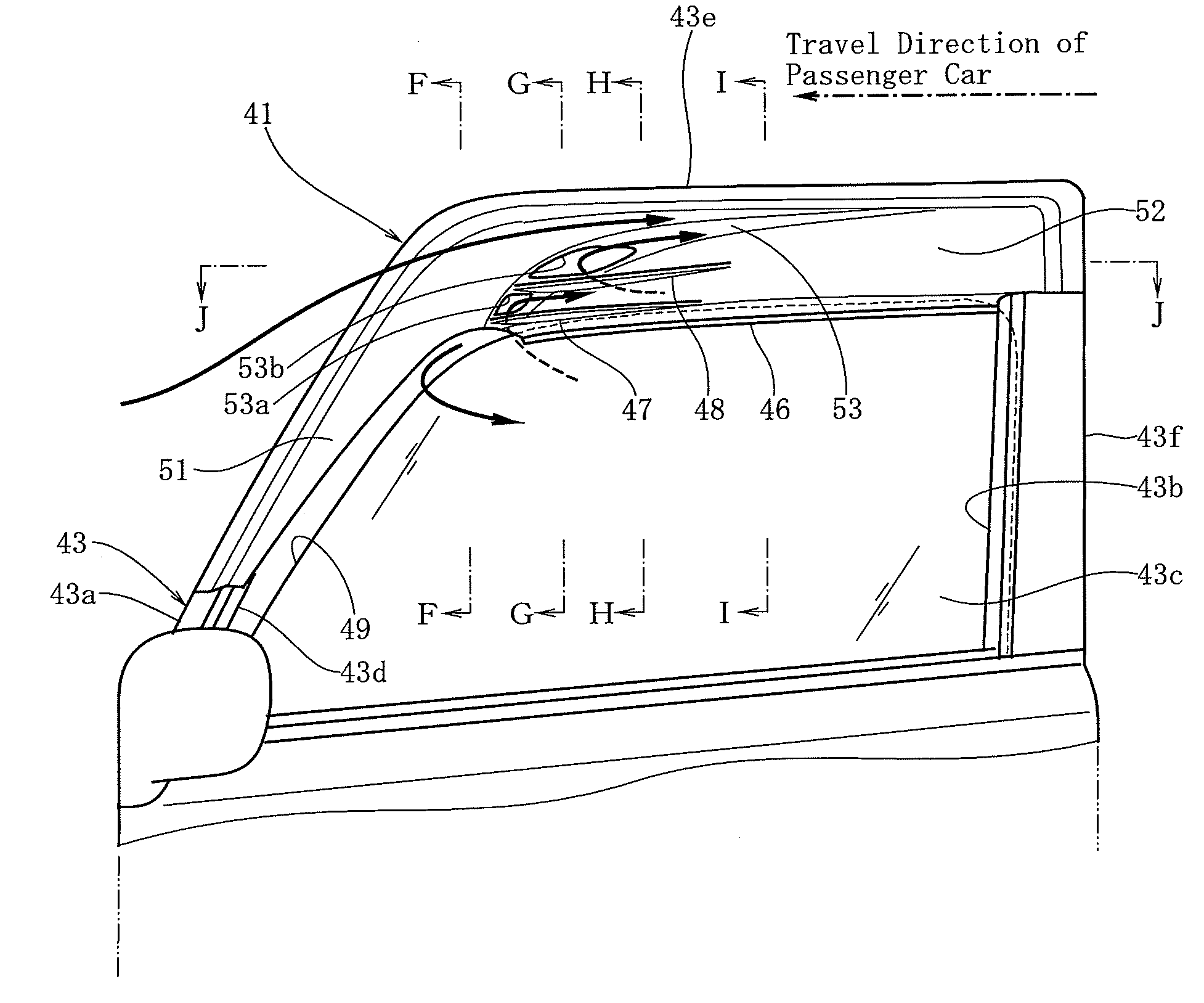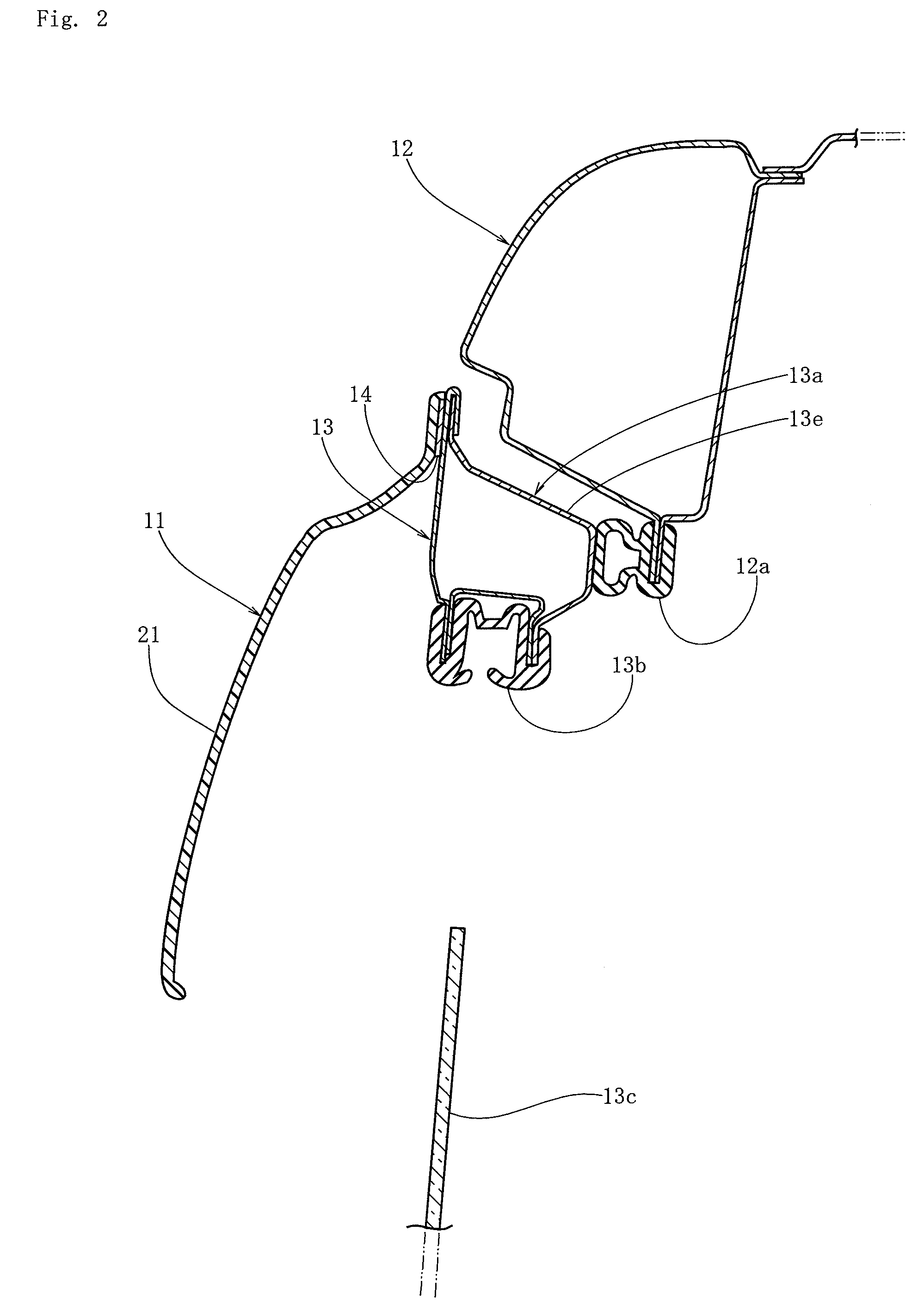Side visor for automobile
a side visor and automobile technology, applied in the field of side visors, can solve the problems of increasing the manpower for manufacturing the side visor, increasing the number of side visor parts, increasing the wind noise, etc., and achieves the effects of increasing wind noise, increasing wind noise, and scarce wind nois
- Summary
- Abstract
- Description
- Claims
- Application Information
AI Technical Summary
Benefits of technology
Problems solved by technology
Method used
Image
Examples
first embodiment
[0053]As shown in FIGS. 8 and 9, a side visor 11 of a first embodiment is mounted to a side door 13 of a cab-over-engine truck 10. Since the side visor 11 is symmetrical in the right-and-left direction with respect to the centerline of vehicle body, the side visor 11 mounted to the side door 13 on the assistant driver's seat side is explained exemplarily, and the explanation of the side visor 11 mounted to the side door 13 on the driver's seat side is omitted (FIG. 8). In the side surface of a cab 12 of the truck 10, a port 12a through which one gets on and off is provided, and this port 12a is closed openably by the side door 13 (FIG. 9). In the upper part of the side door 13, a door window 13b defined by a window frame 13a is formed, and the door window 13b is closed and opened by moving the window glass 13c up and down. The window frame 13a has a front frame part 13d provided on the front side of the side door 13 in such a manner as to be erected so as to be tilted slightly to th...
second embodiment
[0060]FIGS. 10 to 17 show a second embodiment of the present invention. In this embodiment, a side visor 41 is mounted to a side door 43 of a cab-behind-engine type passenger car (FIGS. 16 and 17). Since the side visor 41 is symmetrical in the right-and-left direction with respect to the centerline of vehicle body, the side visor 41 mounted to the side door 43 on the assistant driver's seat side is explained exemplarily, and the explanation of the side visor 41 mounted to the side door 43 on the driver's seat side is omitted (FIG. 16). In the front side surface of the passenger car 40, a port 40a through which one gets on and off is provided, and this port 40a is closed openably by the side door 43 (FIG. 17). In the upper part of the side door 43, a door window 43b defined by a window frame 43a is formed, and the door window 43b is closed and opened by moving the window glass 43c up and down. The window frame 43a has a front frame part 43d provided on the front side of the side door...
third embodiment
[0067]FIG. 18 shows a side visor 61 in accordance with a third embodiment of the present invention. In FIG. 18, the same symbols denote the same elements as those in FIG. 10. In this embodiment, a single through hole 63a is provided so as to be curved upward from the front end of a third covering part 63 and extend to the lengthwise direction of the third covering part 63. Also, a single rib 67 is provided from the lower edge of the single through hole 63a to the outer surface of the second covering part 52 so as to extend substantially to the horizontal direction. The rib 67 is formed integrally with the first to third covering parts 51, 52 and 63. The configurations other than those described above are the same as the configurations of the second embodiment. For the side visor 61 for passenger car configured as described above, since the single through hole 63a is provided so as to be curved upward from the front end of the third covering part 63 and extend to the lengthwise direc...
PUM
 Login to View More
Login to View More Abstract
Description
Claims
Application Information
 Login to View More
Login to View More - R&D
- Intellectual Property
- Life Sciences
- Materials
- Tech Scout
- Unparalleled Data Quality
- Higher Quality Content
- 60% Fewer Hallucinations
Browse by: Latest US Patents, China's latest patents, Technical Efficacy Thesaurus, Application Domain, Technology Topic, Popular Technical Reports.
© 2025 PatSnap. All rights reserved.Legal|Privacy policy|Modern Slavery Act Transparency Statement|Sitemap|About US| Contact US: help@patsnap.com



